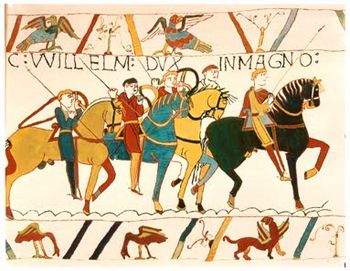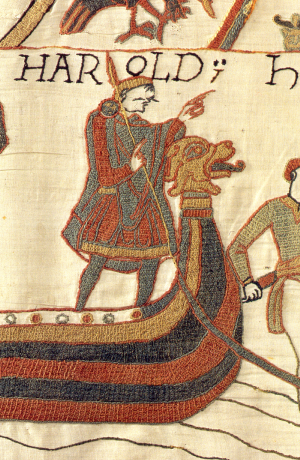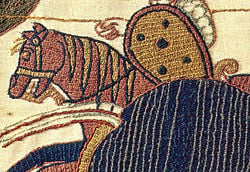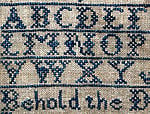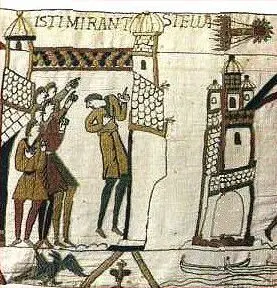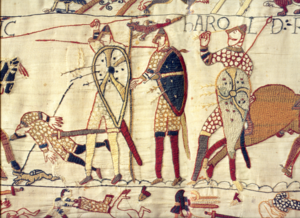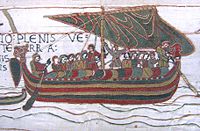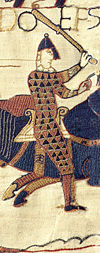Difference between revisions of "Bayeux Tapestry" - New World Encyclopedia
m (→External links) |
m (→References) |
||
| Line 88: | Line 88: | ||
==References== | ==References== | ||
| − | * Beech, George | + | * Beech, George. ''Was the Bayeux Tapestry Made in France?: The Case for St. Florent of Saumur'' (The New Middle Ages), New York, Palgrave Macmillan, 1995. ISBN 9781403966704 |
* Bridgeford, Andrew, ''1066: The Hidden History in the Bayeux Tapestry'', Walker & Company, 2005. ISBN 1841150401 | * Bridgeford, Andrew, ''1066: The Hidden History in the Bayeux Tapestry'', Walker & Company, 2005. ISBN 1841150401 | ||
* Grape, Wolfgang. ''The Bayeux Tapestry: Monument to a Norman Triumph'', Thames & Hudson, 2004. ISBN 9783791313658 | * Grape, Wolfgang. ''The Bayeux Tapestry: Monument to a Norman Triumph'', Thames & Hudson, 2004. ISBN 9783791313658 | ||
* Hicks, Carola. ''The Bayeux tapestry: the life story of a masterpiece'', London: Chatto & Windus, 2006. ISBN 9780701174637 | * Hicks, Carola. ''The Bayeux tapestry: the life story of a masterpiece'', London: Chatto & Windus, 2006. ISBN 9780701174637 | ||
| − | * Netherton, Robin, and Gale R. Owen-Crocker, editors, ''Medieval Clothing and Textiles'', Volume 1 | + | * Netherton, Robin, and Gale R. Owen-Crocker, editors, ''Medieval Clothing and Textiles'', Boydell Press. Volume 1, 2005: ISBN 1843831236; Volume 2, 2006: ISBN 1843832038 |
| − | * Rud, Mogens | + | * Rud, Mogens. ''The Bayeux Tapestry and the Battle of Hastings 1066'', Christian Eilers Publishers, Copenhagen, 2004. ISBN 9788772410203 |
* Wilson, David M.: ''The Bayeux Tapestry'', Thames and Hudson, 1985, ISBN 0500251223 | * Wilson, David M.: ''The Bayeux Tapestry'', Thames and Hudson, 1985, ISBN 0500251223 | ||
| − | * Wilson, David McKenzie, ed. ''The Bayeux Tapestry : the Complete Tapestry in Color,'' Rev. ed. New York: Thames & Hudson, 2004. ISBN 0394547934 | + | * Wilson, David McKenzie, ed. ''The Bayeux Tapestry: the Complete Tapestry in Color,'' Rev. ed. New York: Thames & Hudson, 2004. ISBN 0394547934 |
==External links== | ==External links== | ||
Revision as of 20:47, 28 December 2008
The Bayeux Tapestry (French: Tapisserie de Bayeux) is a 50 cm by 70 m (20 in by 230 ft) long embroidered cloth which depicts the events leading up to the 1066 Norman invasion of England as well as the events of the invasion itself. The Tapestry is annotated in Latin. It is presently exhibited in a special museum in Bayeux, Normandy, France, with a Victorian replica in Reading, Berkshire, England.
Origins of the Tapestry
Since the earliest known written reference to the tapestry is a 1476 inventory of Bayeux Cathedral, its origins have been the subject of much speculation and controversy.
French legend maintained the tapestry was commissioned and created by Queen Matilda, William the Conqueror's wife, and her ladies-in-waiting. Indeed, in France it is occasionally known as "La Tapisserie de la Reine Mathilde" (Tapestry of Queen Matilda). However, scholarly analysis in the 20th century shows it probably was commissioned by William's half brother, Bishop Odo. The reasons for the Odo commission theory include: 1) three of the bishop's followers mentioned in the Domesday Book appear on the tapestry; 2) it was found in Bayeux Cathedral, built by Odo; and 3) it may have been commissioned at the same time as the cathedral's construction in the 1070s, possibly completed by 1077 in time for display at the cathedral's dedication.
Assuming Odo commissioned the tapestry, it was probably designed and constructed in England by Anglo-Saxon artists given that Odo's main power base was in Kent, the Latin text contains hints of Anglo Saxon. Other embroideries originate from England at this time and the vegetable dyes can be found in cloth traditionally woven there.[1][2] Assuming this was the case, the actual physical work of stitching was most likely undertaken by skilled seamstresses. Anglo-Saxon needlework, or Opus Anglicanum was famous across Europe.
One other candidate recently put forward by art historian Carola Hicks, is Edith of Wessex.[3]
Wolfgang Grape, in his The Bayeux Tapestry: Monument to a Norman Triumph (1994), has challenged the consensus that the embroidery is Anglo-Saxon, distinguishing between Anglo-Saxon and other Northern European techniques;[4] however, textile authority Elizabeth Coatsworth refutes this argument.[5]
More recently, George Beech suggests the tapestry was executed at the Abbey of St. Florent in the Loire Valley, and says the detailed depiction of the Breton campaign argues for additional sources in France, in Was the Bayeux Tapestry Made in France?: The Case for St. Florent of Saumur.[6]
Construction and technique
In common with other embroidered hangings of the early medieval period, this piece is conventionally referred to as a "tapestry," although it is not a true tapestry in which the design is woven into the cloth; it is in fact an embroidery.
The Bayeux tapestry is embroidered in wool yarn on a tabby-woven linen ground using two methods of stitching: outline or stem stitch for lettering and the outlines of figures, and couching or laid work for filling in figures. The linen is assembled in panels and has been patched in numerous places.
The main yarn colors are terracotta or russet, blue-green, dull gold, olive green, and blue, with small amounts of dark blue or black and sage green. Later repairs are worked in light yellow, orange, and light greens. Laid yarns are couched in place with yarn of the same or contrasting color.
At the time of the Norman conquest of England, modern heraldry had not yet been developed. The knights in the Bayeux Tapestry carry shields, but there appears to have been no system of hereditary coats of arms. The beginnings of modern heraldic structure were in place, but would not become standard until the middle of the 12th century.
Modern history of the Tapestry
The Bayeux Tapestry was rediscovered in the late 17th century in Bayeux (where it had been traditionally displayed once a year at the Feast of the Relics), and engravings of it were published in the 1730s by Bernard de Montfaucon. Later, some people from Bayeux who were fighting for the Republic wanted to use it as a cloth to cover an ammunition wagon, but luckily a lawyer who understood its importance saved it and replaced it with another cloth. In 1803, Napoleon seized it and transported it to Paris. Napoleon wanted to use the tapestry as inspiration for his planned attack on England. When this plan was canceled, the tapestry was returned to Bayeux. The townspeople wound the tapestry up and stored it like a scroll. (Crack 1) After being seized by the Ahnenerbe, the tapestry spent much of World War II in the basement of the Louvre. (Setton, 209) It is now protected on display in a museum in a dark room with special lighting behind sealed glass in order to minimize damage from light and air. In June 2007, the tapestry was listed on UNESCO's Memory of the World Register.
The plot of the Tapestry
The tapestry tells the story of the Norman conquest of England. The two combatants are the Anglo-Saxon English, led by Harold Godwinson, recently crowned as King of England (before that a powerful earl), and the Normans, led by William the Conqueror. The two sides can be distinguished on the tapestry by the customs of the day. The Normans shaved the back of their heads, while the Anglo-Saxons had mustaches.
The main character of the tapestry is William the Conqueror. William was the illegitimate son of Robert the Magnificent, Duke of Normandy, and Herleva (or Arlette), a tanner's daughter. She was later married off to another man and bore two sons, one of whom was Bishop Odo. When Duke Robert was returning from a pilgrimage to Jerusalem, he was killed. William gained his father's title at a very young age and was a proven warrior at 19. He prevailed in the Battle of Hastings in October 1066 and captured the crown of England at 38. William knew little peace in his life. He was always doing battle, putting down rebel vassals or going to war with France. He was married to his distant cousin Matilda of Flanders. (Barclay 31) William was 1.78 m (5 ft 10 in) tall, and Matilda was 1.27 m (4 ft 2 in).
The tapestry begins with a panel of King Edward the Confessor, who had no son and heir. Edward appears to send Harold Godwinson, the most powerful earl in England to Normandy; the Tapestry does not specify why. When he arrives in Normandy, Harold is taken prisoner by Guy, Count of Ponthieu. William sends two messengers to demand his release, and Count Guy of Ponthieu quickly releases him to William. William, perhaps to impress Harold, invites him to come on a campaign against Conan II, Duke of Brittany. On the way, just outside the monastery of Mont St. Michel, two soldiers become mired in quicksand, and Harold saves the two Norman soldiers. William's army chases Conan from Dol de Bretagne to Rennes, and he finally surrenders at Dinan. William gives Harold arms and armor (possibly knighting him) and Harold takes an oath on saintly relics. It has been suggested, on the basis of the evidence of Norman chroniclers, is that this oath was a pledge to support William's claim to the English throne, but the Tapestry itself offers no evidence of this. Harold leaves for home and meets again with the old king Edward, who appears to be remonstrating with Harold. Edward's attitude here is reprimanding towards Harold, and it has been suggested that he is admonishing Harold for making an oath to William. Edward dies, and Harold is crowned king. It is notable that in the Bayeux Tapestry, the ceremony is performed by Stigand, whose position as Archbishop of Canterbury was controversial. The Norman sources all name Stigand as the man who crowned Harold, in order to discredit Harold; the English sources suggest that he was in fact crowned by Aldred, making Harold's position as legitimate king far more secure.
Halley's Comet
A star with streaming hair then appears: Halley's Comet. The first appearance of the comet would have been April 24, nearly four months after Harold's coronation. Comets, in the beliefs of the Middle Ages, warned of impending doom. The news of Harold's coronation is taken to Normandy, where William then builds a fleet of ships. The invaders reach England, and land unopposed. William orders his men to find food, and a meal is cooked. A house is burnt, which may indicate some ravaging of the local countryside on the part of the invaders. News is brought to William, possibly about Harold's victory in the Battle of Stamford Bridge, although the Tapestry does not specify this. The Normans build a mote and bailey to defend their position. Messengers are sent between the two armies, and William makes a speech to prepare his army for battle.
The Battle of Hastings was fought on October 14, 1066. The English fight on foot behind a shield wall, while the Normans are on horses. The first to fall are named Leofwine Godwinson and Gyrth Godwinson, Harold's brothers. Bishop Odo also appears in battle. The section depicting the death of Harold can be interpreted in different ways, as the name "Harold" appears above a lengthy death scene, making it difficult to identify which character is Harold. It is traditionally believed that Harold is the figure with the arrow in his eye. But he could also be the figure just before with a spear through his chest, the character just after with his legs hacked off, or could indeed have suffered all three fates or none of them. The English then flee the field.
Mysteries of the tapestry
The tapestry contains several mysteries:
- There is a panel with what appears to be a clergyman touching or possibly striking a woman's face. No one knows the meaning of the inscription above this scene (ubi unus clericus et Ælfgyva, "where [we see] a certain cleric and Ælfgifu," a woman's name, although some authorities have claimed otherwise). There are two naked male figures in the border below this figure; the one directly below the figure is squatting and displaying prominent genitalia, a scene that was frequently censored in former reproductions. Historians speculate that it may represent a well known scandal of the day that needed no explanation.
- At least two panels of the tapestry are missing, perhaps even another 6.4 m (7 yards) worth. This missing area would probably include William’s coronation.
- The identity of Harold II of England in the vignette depicting his death is disputed. Some recent historians disagree with the traditional view that Harold II is the figure struck in the eye with an arrow. The view that it is Harold is supported by the fact that the words Harold Rex (King Harold) appear right above the figure's head. However, the arrow may have been a later addition following a period of repair. Evidence of this can be found in a comparison with engravings of the tapestry in 1729 by Bernard de Montfaucon, in which the arrow is absent. A figure is slain with a sword in the subsequent plate and the phrase above the figure refers to Harold's death (Interfectus est, "he is slain"). This would appear to be more consistent with the labeling used elsewhere in the work. However, needle holes in the linen suggest that, at one time, this second figure was also shown to have had an arrow in his eye. It was common medieval iconography that a perjurer was to die with a weapon through the eye. So, the tapestry might be said to emphasize William's rightful claim to the throne by depicting Harold as an oath breaker. Whether he actually died in this way remains a mystery.
- Above and below the illustrated story are to be found "the marginalia" i.e. background information, for example showing the season of the year, the plundering of war booty and many symbols and pictures of uncertain significance.
Reliability
While political propaganda or personal emphasis may have somewhat distorted the historical accuracy of the story, the Bayeux tapestry presents a unique visual document of medieval arms, apparel, and other objects unlike any other artifact surviving from this period. Nevertheless, it has been noted that the warriors are depicted fighting with bare hands, while other sources indicate the general use of gloves in battle and hunt.
Also, the tapestry shows Harold enthroned with Stigand, the Archbishop of Canterbury, beside him, as though he has been crowned by him. Harold was actually crowned by Aldred of York, more than likely because Stigand, who received his place by self-promotion, was considered corrupt. The tapestry tries to show a connection between Harold and the bishop, making his claim to the throne even weaker.
As the tapestry was made under Odo's command, he will have changed the story, although he was there at the battle of Hastings, he was William's half brother. This means he would try to make William look good, and Harold look bad, so when Harold swore to help William, did he really swear?
Revisionist theory
Some historians, including Andrew Bridgeford in his book 1066: The Hidden History of the Bayeux Tapestry, have suggested that the tapestry was actually of English design and encoded with secret messages meant to undermine Norman rule.
Replicas
There are a number of replicas of the Bayeaux Tapestry in existence. A full-size replica of the Bayeux Tapestry was finished in 1886 and is exhibited in the Museum of Reading in Reading, Berkshire, England. Victorian morality required that a naked figure in the original tapestry (in the border below the Ælfgyva figure) be depicted wearing a brief garment covering his genitals. Starting in 2000, the Bayeux Group, part of the Viking Group Lindholm Høje, has been making an accurate replica of the Bayeux Tapestry in Denmark, using the original sewing technique, and natural plant-dyed yarn.
In popular culture
Because it resembles a movie storyboard and is widely recognized and, by modern standards at least, so distinctive in its artistic style, the Bayeux Tapestry has been used in a variety of different popular culture contexts. The tapestry has inspired later embroidery and artwork, particularly those involving invasions (such as the Overlord embroidery now at Portsmouth). It was also redone on the July 15, 1944 cover of the New Yorker magazine to commemorate D-Day. A number of films have used sections of the tapestry in their opening credits or closing titles, including: the Disney film Bedknobs and Broomsticks, Anthony Mann's El Cid, Zeffirelli's Hamlet, Frank Cassenti's La Chanson de Roland, Robin Hood: Prince of Thieves, and Richard Fleischer's The Vikings.
In the television show The Simpsons, the Bayeux tapestry is featured in the "couch gag" of the Season 19 episode E Pluribus Wiggum, and repeated in the episode Apocalypse Cow.
According to the website whoisdoctorwho, the Doctor appears in the tapestry with Rose Tyler and the TARDIS next to him. This is fictional, though as the tapestry has no blue box or young girl in it, at least not a time traveling girl.
See also
- Battle of Hastings
- William the Conqueror
- Halley's Comet
- Matilda of Flanders
Notes
- ↑ Wilson, David M., 1985, p.201-227.
- ↑ Coatsworth, Elizabeth: "Stitches in Time: Establishing a History of Anglo-Saxon Embroidery," in Netherton Owen-Crocker, ed., Medieval Clothing and Textiles, Volume 1, 2005, p. 1-27.
- ↑ "New Contender for The Bayeux Tapestry?", BBC, May 22, 2006. Retrieved December 26, 2008.
- ↑ Grape, Wolfgang, 2004.
- ↑ "The attempt to distinguish Anglo-Saxon from other Northern European embroideries before 1100 on the grounds of technique cannot be upheld on the basis of present knowledge." In Coatsworth, "Stitches in Time: Establishing a History of Anglo-Saxon Embroidery," in Netherton Owen-Crocker, ed., Medieval Clothing and Textiles, Volume 1, 2005, p.26.
- ↑ Beech, George, 1995.
ReferencesISBN links support NWE through referral fees
- Beech, George. Was the Bayeux Tapestry Made in France?: The Case for St. Florent of Saumur (The New Middle Ages), New York, Palgrave Macmillan, 1995. ISBN 9781403966704
- Bridgeford, Andrew, 1066: The Hidden History in the Bayeux Tapestry, Walker & Company, 2005. ISBN 1841150401
- Grape, Wolfgang. The Bayeux Tapestry: Monument to a Norman Triumph, Thames & Hudson, 2004. ISBN 9783791313658
- Hicks, Carola. The Bayeux tapestry: the life story of a masterpiece, London: Chatto & Windus, 2006. ISBN 9780701174637
- Netherton, Robin, and Gale R. Owen-Crocker, editors, Medieval Clothing and Textiles, Boydell Press. Volume 1, 2005: ISBN 1843831236; Volume 2, 2006: ISBN 1843832038
- Rud, Mogens. The Bayeux Tapestry and the Battle of Hastings 1066, Christian Eilers Publishers, Copenhagen, 2004. ISBN 9788772410203
- Wilson, David M.: The Bayeux Tapestry, Thames and Hudson, 1985, ISBN 0500251223
- Wilson, David McKenzie, ed. The Bayeux Tapestry: the Complete Tapestry in Color, Rev. ed. New York: Thames & Hudson, 2004. ISBN 0394547934
External links
All links retrieved December 26, 2008.
- The Bayeux Tapestry (Bibliotheca Augustana, 8 MB) (Best images online)
- Bayeux Tapestry Museum
- in QuickTime VR panorama (click and drag the image on the right…)
- Latin-English translation
- Britain's Bayeux Tapestry
- The Bayeux Tapestry thumbnails
- Bayeux Tapestry Image Gallery
| ||||||||||||||||||||||||||||
Credits
New World Encyclopedia writers and editors rewrote and completed the Wikipedia article in accordance with New World Encyclopedia standards. This article abides by terms of the Creative Commons CC-by-sa 3.0 License (CC-by-sa), which may be used and disseminated with proper attribution. Credit is due under the terms of this license that can reference both the New World Encyclopedia contributors and the selfless volunteer contributors of the Wikimedia Foundation. To cite this article click here for a list of acceptable citing formats.The history of earlier contributions by wikipedians is accessible to researchers here:
The history of this article since it was imported to New World Encyclopedia:
Note: Some restrictions may apply to use of individual images which are separately licensed.
